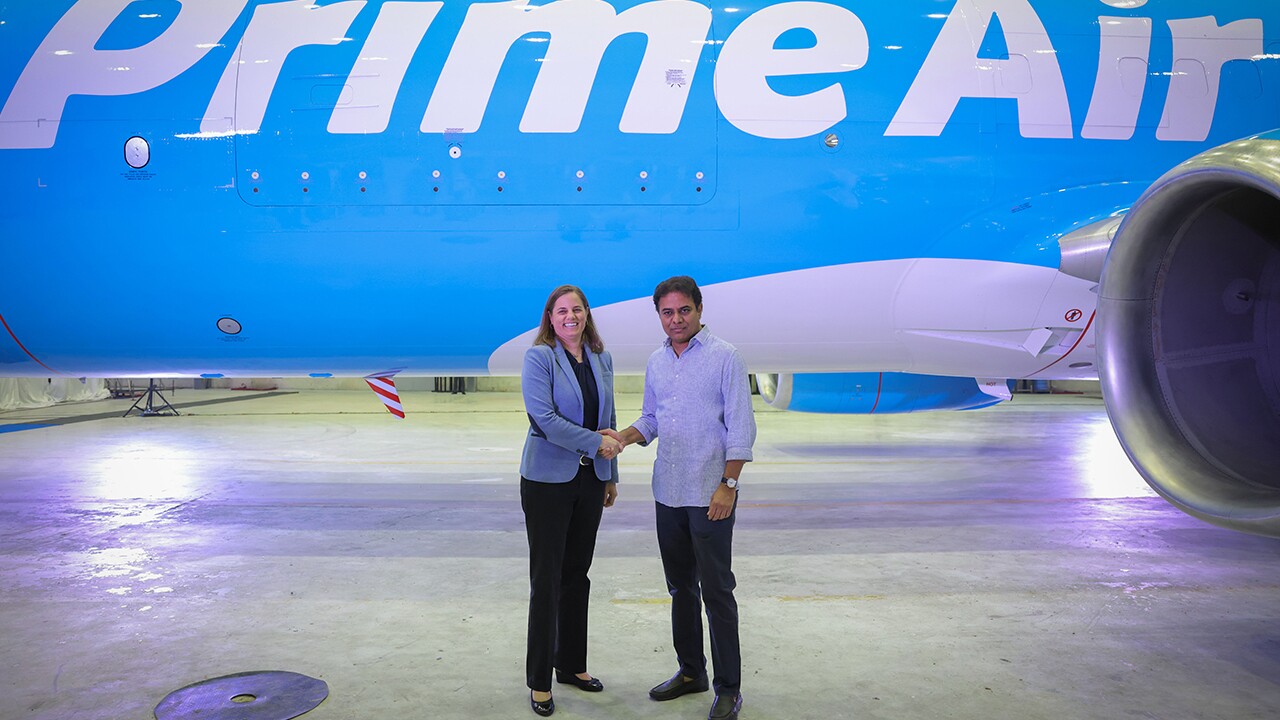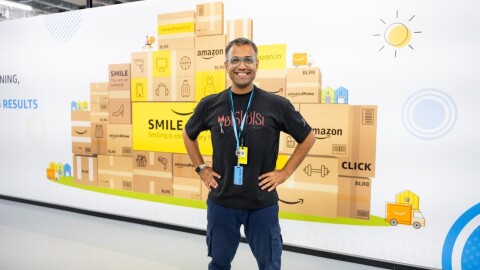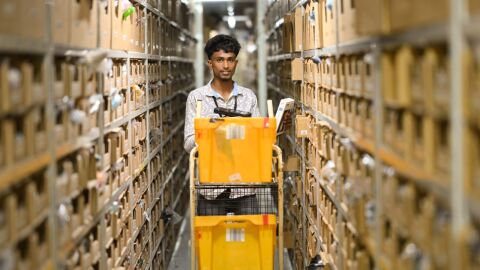A year before finishing naval service, Sarah envisioned a three-point checklist to figure out life beyond the flight deck. After more than a decade of flying around the world in operational roles, Sarah was clear that her future profession had to meet three requirements. Amazon checked all the boxes—and continues to do so every day, even after nearly 12 years with the company.
“We do some really incredible things: building out an air haul network within an e-commerce company is definitely not something I thought I’d be doing when I joined Amazon 12 years ago,” Sarah told About Amazon India. As Vice President of Amazon Global Air, an air cargo network of 110 aircraft globally and over 70 on-airport locations, she has leveraged her military operational precision, aviation background, engineering education, and Amazon supply chain experience to innovate on behalf of Amazon’s customers.
Recently, Sarah was in Hyderabad to launch Amazon Air in India—two Boeing 737-800 freighter aircraft operated by Quikjet Cargo Airlines that can ship approximately 20,000 packages per flight across Mumbai, Delhi, Hyderabad, and Bangalore. In a free-wheeling conversation, Sarah talks about her journey and explains why Amazon Air chose India as its first destination in Asia. Edited excerpts.
1. About 12 years back, you pivoted from being a F/A-18 Navy pilot to joining Amazon as an operations leader. Looking back, what motivated you to join the company and stay on for more than a decade?
A year before concluding naval service, I began thinking about what to do next. I had three criteria in mind for my next role. First, I wanted to work with and lead large teams of people. Second, I didn't want to sit behind a desk every day and do the same thing day in and day out. Third, I wanted to be challenged in a positive way, just like I was serving in the military. Almost 12 years later, I can say that these three criteria are still met every single day. I'm excited when I get up in the morning to start the day, and I’m grateful to work with such a motivated, inspiring team of leaders and builders who have made the impossible, possible. We do some pretty cool things: building an air cargo network within an e-commerce company is definitely not something I thought I’d be doing when I joined Amazon 12 years ago.
2. Are there certain aspects about your Navy days that you miss?
Well, I'm not flying in my current role and on a nice sunny day, it would be fun to jump into an aircraft and take it for a flight. However, I have a commercial pilot's license that I can use if I’d like to at any time in the future. Also, I do miss a lot of the people with whom I served across the globe, but, overall, I feel really content about my time as a naval pilot and military service, so no regrets.
3. Let’s shift gears and speak about Amazon Air at large. Could you help our readers understand the size and scale of Amazon Air’s operations globally?

Globally, we have over 110 aircraft including the two aircraft that we launched in India, and we serve more than 70 on-airport locations, including four air “gateway” facilities in India. Field operations are largely concentrated in the U.S., but we also have field operations in Europe and Canada as well. Currently, we have nearly 14,000 Amazon Air leaders and associates who are mostly based in the U.S. We also have a team in Europe, and we partner very closely with the teams in Canada, and now, in India.
4. Why did the Amazon Air team choose India for its foray into Asia?
When we start with the customer—as we do at Amazon—we work backwards. We want to make sure that we're satisfying the needs of our customers, and that includes speed of service. In partnership with the India leadership team, we chose India because it is one of a few countries in Asia that has a dedicated marketplace (Amazon.IN) with fulfillment centers spread around the country. So, there is inventory across the country that we want to be able to offer our customers in two days or less. In order to meet our delivery promise, we sometimes require dedicated aircraft so we can tailor our flight schedules to accommodate our fulfillment center timings and needs versus relying on another transportation provider’s schedule. This allows us end to end visibility of our customers' packages, and we can test the impact on the customer experience. It’s exciting for us and the customer!
5. Will Amazon Air start its own field operations in India too at some point?
Right now, we are starting with third-party service providers just like we did in the U.S. Our general approach at Amazon Air, which has proven successful throughout the past five years, is to crawl, then walk, then run. For example, we started our organization by “crawling” with a small team and outsourcing all of our operations to 3P service providers. We are now in the “walk” phase where we have invested in our infrastructure and brought functions such as operations of our larger on-airport field facilities “in house.” During this walk phase, we have also expanded in other geographies such as Europe, Canada, and now, India. Stay tuned for what’s to come in the “run” phase….

6. As a customer, will I have to pay more if my package is being shipped on one of your aircraft?
No, we don't increase costs for our customers because we're adding aircraft to our network. We look at our costs internally end-to-end. At the end of the day, our customers aren’t as concerned about how they receive their packages – they care about having great selection at low cost with on-time deliveries.
7. Will Amazon Air also service transcontinental freight in the future?
Presently, the two aircraft will be dedicated to intra-India operations. However, that doesn't mean that there may not be some opportunity in the future to do some cross-border work. But right now, we're focused on intra-India shipments.
8. Freight carried across Indian airports increased 27% to 3.1 million tons in FY2022. Eventually, is there a plan for Amazon Air to haul third party shipments in India?
We've planned our capacity based on the needs of Amazon customers. If we plan for more than that, it would probably mean we may be bringing on too much capacity. That being said, it’s possible that we may have some extra space on a flight from time to time. So, if there's an opportunity to help offset our costs by offering up that space, we'll certainly look to evaluate that at the right time.
9. Over the next 2-3 years, what are your expectations from Amazon Air in India?
Over the next three years, Amazon will continue to invest in building logistical infrastructure in India to strengthen its network and cater to the growing customer needs. We plan to focus on fulfilling our fast, seamless delivery promise across the length and breadth of the country, and Amazon Air’s growth in India will be based on business requirements and our customer – a similar approach as in other geographies where potential exists.













